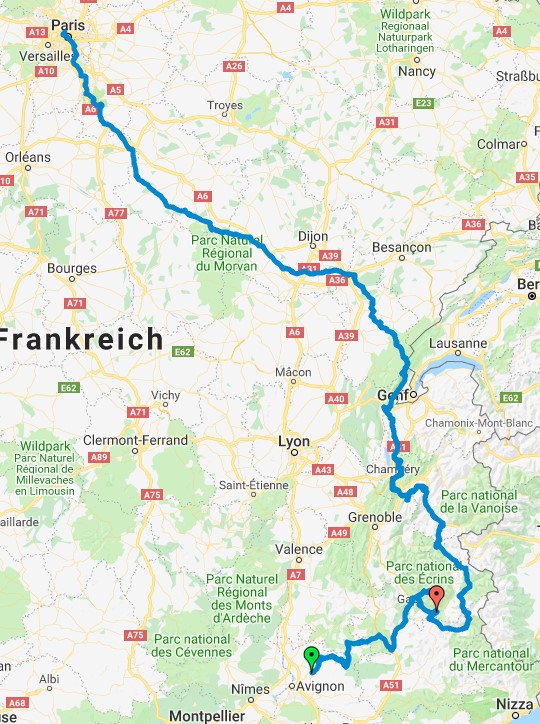A grand tour, 3 weeks, 20 stages, 3’300 km, 42’000 altitute meters.
From June 16 to July 7, we follow the 20 stages of the 1972 Tour de France, which we think is the best continuous loop that takes us over the classic routes and famous mountains, without costly and time consuming transfers. You could also say: In the footsteps of Eddy Mercks.

This is now a real loop – Le Loop – as the tour is called in France. The first week on the Atlantic coast, down the Bay of Biscay to the Pyrenees, the second week further over the legendary Pyrenean passes (Col du Marie Blanche, Col du Aspique, Col du Turmalet, Col du Aspin, …) over to Provence, over Mont Ventoux to the Maritime Alps and the third week in the Haute Savoie, Haute Alpes (Col du Galibier, Col du Telegraph, Col du Isoard) to Paris.
Why are we doing an historical route rather than riding the current one of 2019?
Of course, we still have contacts from the Tour de Force of 2017 and we always had in mind to do another Grand Tour, a 3-week tour. Because it is the 3 weeks that make the adventure so special. Since we had already completed the Tour of France, it should rather be a La Vuelta Espania or the Giro d’Italia. Unfortunately, we found, despite extensive search, no organizers who could or wanted to lift that. So we already considered to organize a tour ourselves. Finally we asked organizers, who have the know how and the capacities, if they would like to organize a tour for us. We would take care of the customers, the other riders, so that a good peloton would come together. And so now this loop has come about and if that goes well, we will use the concept next year for the Tour of Spain.
Changes and Features compared to the Tour of 2017
Markings – This time we will have to do without arrows. At the 2017 Tour de Force, the route was perfectly marked with black arrows on a yellow background and we easily found our way. This time there are not so many volunteers to set the arrows at 5am and collect them again in the evening. We ride this time with routing devices, for example Garmin, and previously defined GPX routes. For longer routes we will have power problems here, so don’t forget charged powerbanks. The GPX data we got in advance and I must say, very accurately created with about 3000 waypoints per stage, which makes me confident.
Weather – This tour will take place about 4 weeks earlier. We will possibly have to deal with heavy winds at the Atlantic and especially in the Alps with cold, stormy weather. Hopefully it won’t rain again for a week like it did in the 2017 Tour.
Peloton – As of today (Mar’19), there are 16 riders – English “Lifers” – who will be there for the entire Tour, the entire 3 weeks. In addition, there are another 14-20 riders who will ride individual sections – starting from rest day. This is not a 200th rider field this time, but it offers more support for the individual.
Week One – from the Atlantic Ocean to the Pyrenees

A typical start with flat stages along the Atlantic coast down to Spain and forward into the Pyrenees.
Can think that here at the time of year can still blow fierce wind in.
Otherwise, I’m looking forward to get to know this strip of landscape, although we have to skip the wine tasting in Bordeaux. The only pity is that we drive around La Rochele.
At the end of the first week, however, we’ll head into the wonderful Pyrenees with initially easy climbs and where, after 6 stages, we’ll already have our first rest day in Eaux Bonnes. This abandoned former spa town I still know from the Pyrenees tour.
Week Two – Trans-Pyrenees to the Provence

Now it’s getting serious. Directly after the rest day comes perhaps the most difficult stretch of this tour, there are 5 mountains to conquer. Yes in a single day we drive the route over the Col d’Aubisque (1709m), Col du Soulor (1474m), Col du Tourmalet (2115m), Col d’Aspin (1489m) and the Col de Peyresourde (1569m). But since I have driven exactly the same route with the exception of the last mountain already in 2016, it does not scare me so, unless it rains again and is cold at the Tourmalet.
Until the next rest day in Capentiras are then only a few Col’s to cross and the journey goes into the summery Provence.
Week Three – Haute Aples to Paris

But that’s not all, this time the 3th week seems to me to be the most demanding.
We now have 6 stages with violent and high climbs ahead of us, which I do not want to list here, otherwise I’m still afraid.
We are talking about Col du Galibier (2642m) and Col du Isoard (2405m) as highlights. But we have already driven the two at the Tour 2017 and have also survived it …
Route of the Tour de France of the year 1972
